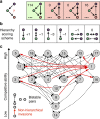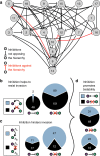Inhibitory interactions promote frequent bistability among competing bacteria
- PMID: 27097658
- PMCID: PMC4844671
- DOI: 10.1038/ncomms11274
Inhibitory interactions promote frequent bistability among competing bacteria
Abstract
It is largely unknown how the process of microbial community assembly is affected by the order of species arrival, initial species abundances and interactions between species. A minimal way of capturing competitive abilities in a frequency-dependent manner is with an invasibility network specifying whether a species at low abundance can increase in frequency in an environment dominated by another species. Here, using a panel of prolific small-molecule producers and a habitat with feast-and-famine cycles, we show that the most abundant strain can often exclude other strains--resulting in bistability between pairs of strains. Instead of a single winner, the empirically determined invasibility network is ruled by multiple strains that cannot invade each other, and does not contain loops of cyclic dominance. Antibiotic inhibition contributes to bistability by helping producers resist invasions while at high abundance and by reducing producers' ability to invade when at low abundance.
Figures




References
-
- Martiny J. B. H. et al.. Microbial biogeography: putting microorganisms on the map. Nat. Rev. Microbiol. 4, 102–112 (2006) . - PubMed
-
- Drake J. A. Community-assembly mechanics and the structure of an experimental species ensemble. Am. Nat. 137, 1–26 (1991) .
-
- Ives A. R. & Carpenter S. R. Stability and diversity of ecosystems. Science 317, 58–62 (2007) . - PubMed
-
- Chesson P. Mechanisms of maintenance of species diversity. Annu. Rev. Ecol. Syst. 31, 343–366 (2000) .
-
- Davis M. A., Thompson K. & Grime J. P. Invasibility: the local mechanism driving community assembly and species diversity. Ecography 28, 696–704 (2005) .
Publication types
MeSH terms
Substances
LinkOut - more resources
Full Text Sources
Other Literature Sources

